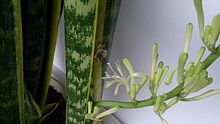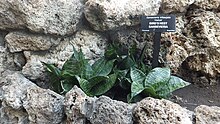PLANT CARE ( Sansevieria Trifasciata | Snake Plant | Mother-in-laws Tongue ) BUY NOW
 |
A temperature range between 70 and 90 degrees is best. |
 |
Sansevieria Trifasciata | Snake Plant | Mother-in-laws Tongue plants prefer indirect but steady light with some direct sun. |
 |
Easily tolerates dry atmosphere. |
 |
Let the soil dry between watering. During winter, reduce watering to monthly. |
ADDITIONAL CARE
Sansevieria Trifasciata | Snake Plant | Mother-in-laws Tongue is easy to grow and is nearly indestructible; they will thrive in either very bright light or almost dark corners of the house. An ideal container plant is excellent in a grouping and will grow equally well on the floor or on tabletop displays. These plants are also drought-resistant. There are two low-growing varieties, but these are rarely seen in garden centres. Sansevieria Trifasciata | Snake Plant | Mother-in-laws Tongue species are low maintenance plants, easy to grow and recommended as plants with a big contribution in improving air quality in living and working spaces. Sansevieria Trifasciata will survive in a wide range of conditions. They tolerate the low light conditions (60-80% shade) and are very drought tolerant.
Dracaena trifasciata is a species of flowering plant in the family Asparagaceae, native to tropical West Africa from Nigeria east to the Congo. It is most commonly known as the snake plant, Saint George’s sword, mother-in-law’s tongue, and viper’s bowstring hemp, among other names.[2] Until 2017, it was known under the synonym Sansevieria trifasciata.[1]
Description
It is an evergreen perennial plant forming dense stands, spreading by way of its creeping rhizome, which is sometimes above ground, sometimes underground. Its stiff leaves grow vertically from a basal rosette. Mature leaves are dark green with light gray-green cross-banding and usually range from 70–90 centimetres (2.3–3.0 ft) long and 5–6 centimetres (2.0–2.4 in) wide, though it can reach heights above 2 m (6 ft) in optimal conditions.[3]
The specific epithet trifasciata means “three bundles”.[4]
The plant exchanges oxygen and carbon dioxide using the crassulacean acid metabolism process, which allows them to withstand drought. The microscopic pores on the plant’s leaves, called the stomata and used to exchange gases, are only opened at night to prevent water from escaping via evaporation in the hot sun. It is a weed in some parts of northern Australia.[5]
Common names
Dracaena trifasciata is commonly called “mother-in-law’s tongue“, “Saint George‘s sword” or “snake plant”, because of the shape and sharp margins of its leaves.[2] It is also known as the “viper’s bowstring hemp”, because it is one of the sources for plant fibers used to make bowstrings.[6]
Cultivation and uses
Like some other members of its genus, D. trifasciata yields bowstring hemp, a strong plant fiber once used to make bowstrings.
It is now used predominantly as an ornamental plant, outdoors in warmer climates, and indoors as a houseplant in cooler climates. It is popular as a houseplant because it is tolerant of low light levels and irregular watering; during winter it needs only one watering every couple of months. It will rot easily if overwatered.[7] It is commonly recommended to beginners interested in cultivating houseplants for its easy care.[8]
Dracaena trifasciata ‘Hahnii’, a dwarfed cultivar
The NASA Clean Air Study found D. trifasciata has potential to filter indoor air, removing 4 of the 5 main toxins involved in the effects of sick building syndrome.[9] However, its rate of filtration is too slow for practical indoor use.[10]
It can be propagated by cuttings or by dividing the rhizome. The first method has the disadvantage that the variegation will be lost.[11]
D. trifasciata is considered by some authorities as a potential weed in Australia, although widely used as an ornamental, in both the tropics outdoors in both pots and garden beds and as an indoor plant in temperate areas.[12]
The plant contains saponins which are mildly toxic to dogs and cats and can lead to gastrointestinal upset if consumed.[13]
Varieties and cultivars
Numerous cultivars have been selected, many of them for variegated foliage with yellow or silvery-white stripes on the leaf margins. Popular cultivars include ‘Compacta’, ‘Goldiana’, ‘Hahnii’, ‘Laurentii’, ‘Silbersee’, and ‘Silver Hahnii’. ‘Hahnii’ was discovered in 1939 by William W. Smith, Jr. in the Crescent Nursery Company, New Orleans, Louisiana. The 1941 patent was assigned to Sylvan Frank Hahn, Pittsburgh, Pennsylvania.[14]
The variety D. trifasciata var. laurentii,[15] together with the cultivars ‘Bantel’s Sensation’[16] and ‘Golden Hahni’[17] have gained the Royal Horticultural Society‘s Award of Garden Merit.[18]
Cultural significance
In its native range in Africa, a yellow-tipped cultivar is associated with Oya, the female Orisha of storms. In Nigeria it is commonly linked with Ogun, the Orisha of war, and is used in rituals to remove the evil eye.[19] In Brazil its common name Espada de São Jorge links it to Saint George, who by syncretism is also associated with Orisha Ogun.[20]






